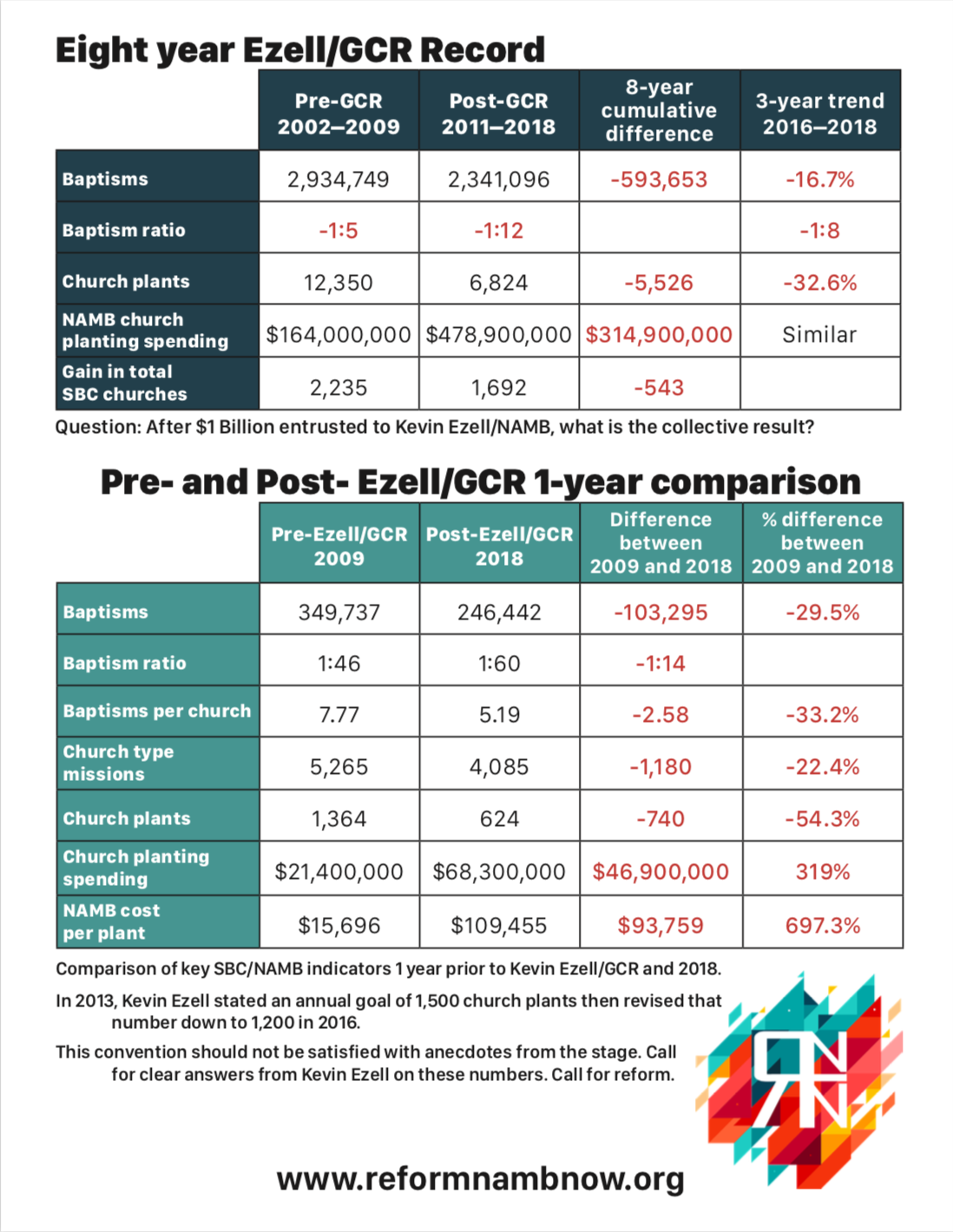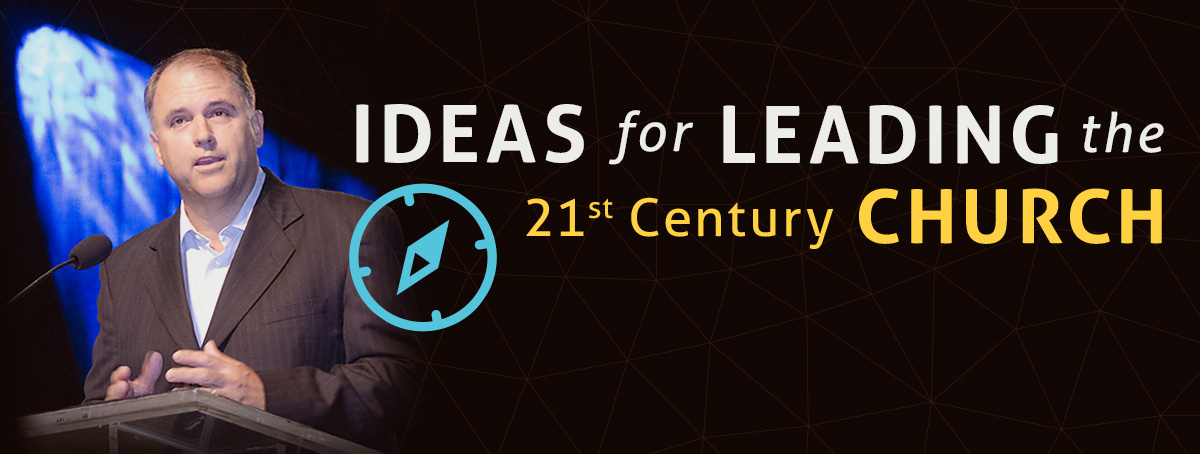The 2010 SBC Great Commission Resurgence (GCR) intentionally brought radical shifts in NAMB’s leadership, strategy, and priorities in funding and staff. Are Southern Baptists better off and stronger, or worse off and weaker? What are the measurable results and the impact on the self-regenerating missions funding and sending system? What is happening at the local level in the midst of the national rebranding and PR efforts? (NAMB transitioned to a team of 30 staff members in Events and Marketing and 1.5 Evangelism staff members)
1. 70 year Lows in SBC Baptisms, both Nationally, and per Church
The decline in total baptisms is rapidly picking up speed, and baptism ratios are worsening. SBC churches baptized 600,000 less people the last 8 years than the 8 years prior to the GCR. NAMB not only terminated virtually all of their national evangelism staff, they eliminated SB funding for evangelism staff in partnership with State Conventions. The NAMB President recently announced to the State Execs further cuts in evangelism through State Conventions to local churches to fund a speaking tour approach. Southern Baptists agree that evangelism is a biblical command for all. The Bible reveals that God has given evangelists to the churches. However, during the NAMB President said in his address to the SBC in June 2016, “church planting is evangelism.” Is that so?
2. 40 year Lows in number of SBC Churches Started
Southern Baptists are planting less than half the number of churches post GCR, but spending 3.5 times more money to plant fewer churches. In 2018, the SBC saw only 624 new churches compared to the high of 1,781 new plants in 2004 and 1,578 in 2008. NAMB wrestled control of planting outside of the south from local leaders and partners in State Conventions and Associations. The controls for the national assignment of NAMB was then largely handed off to a few local mega churches. The result… in 2018, historic low number of plants and NAMB only reported assessing 220 church planters. Claims of better plants with much higher survivability is not proven out in the facts. The total number of churches started and surviving is radically lower.
3. Weakened Partnerships
One retired State Executive Director stated, “partnership is dead in the SBC”. Weakened and broken partnerships with State Conventions and Associations has been a mark or stain of the post GCR strategies. Historically non-Southern Associations received funding to be the face of the SBC outside of the South, but they have been defunded by NAMB post GCR. First NAMB sought to make the non-Southern DOM/AMS church planting catalysts and then defunded them completely. In spite of brand new efforts by NAMB to woo AMSs, publicly and strategically Associations and States have been marginalized. Has this contributed to the record lows in baptisms and church planting?
Furthermore, regional mission, ministry and evangelism efforts all across the US have been cut (Ocean City International Missions in Maryland, Brantley Center in New Orleans, Appalachian Mountain Ministry). These places provided a place for Southern Baptists, young and older, to get their first taste of missions while seeing SBC cooperation and partnership at work. However, NAMB has abandoned those efforts. See NW State Exec Dr. Randy Adams’ outstanding article on the importance of Cooperations with local leaders in the SBC. https://randyadams.org/2018/06/07/trust-and-partnership-a-recovery-program-for-the-sbc/
4. Mega Church Focus
Focus has shifted to working with and funding select mega churches. However, existing churches have received less focus and fewer helps from the SBC nationally. More SBC missions money entrusted to NAMB is going to start a few high profile, highly funded churches and to start new campuses of favored mega churches. Concerns are being expressed that some of those “campuses” are not growing from effective evangelistic efforts, but rather are drawing people and resources from existing churches in that area.
For one new church plant in Pennsylvania, NAMB purchased a church building for $500,000, built the planter a brand new $500,000 home, and also hired two church planters as they merged into the new plant. NAMB gave them titles and jobs in Send Relief and as a Send City Coordinator. NAMB has committed to spending $62 million to purchase houses for temporary housing for planters, 40% of them over $400,000. Of note, larger houses seem to be in the hands of people who are somehow connected to the NAMB President or an influential mega church or are controlled not for planters, but for a mega church pastor to host someone they place in the home. In a 2010 published interview Ezell said, “I can see where someone might say, ‘Well, he will just give money to his friends to plant churches.” Let’s #OpenTheBooks in a new demonstrated commitment to TRANSPARENCY and see to whom the money has gone.
5. Nationalization of the SBC
In a “Washington knows best” approach, the SBC national has transitioned intentionally to be less responsive to the local leaders and more directive and more centralized in setting strategies, priorities, and goals with mission funds. This was one of the stated objectives of the GCR. As well, NAMB transitioned money from a broad approach to evangelism, missions and church planting to a nationalized approach to church planting while gutting evangelism.
Instead of being a resource and responding to local leaders and strategies, NAMB began working around them, even in Disaster Relief. NAMB recently spent $11 million to set up one Send Relief location/property, Clarkston, GA, Local leaders are the best resources to know and meet the varied needs of people in their area. Furthermore, for new members of SBC cooperating churches outside of the South, they KNOW NOT Lottie, Annie, NAMB, IMB, the CP or EC or the SBC. They know the local and state leaders in front of them. When times get tough, local, not national, matters more!
For a Deeper Dive into “Is NAMB Working?”
In the spring of 2017 I did a series of articles on “Is the New NAMB Working?” I explored several areas: (1) Introduction/Questions to Consider, (2) Baptisms, (3) Church Planting, (4) Partnership and the SBC Ecosystem, (5) Financial Stewardship, (6) Leadership and (7) Oversight and Accountability. You can find these articles at https://willmcraney.com/category/namb/
Conclusion
Regardless of the varied intentions of the 2010 voters, the power play that was the GRC has been a complete failure (excluding a few mega churches and those receiving significant NAMB funding). Make no mistake about it, the GCR was a successful play for power. However, failure accompanied it with both obvious and unseen damages to the Southern Baptist mission and partners. As was part of the celebrity driven plan, we have a weaker, maybe neutered Executive Committee. Maybe we need new LEADERSHIP, a new DIRECTION, and a new real commitment to COOPERATION and PARTNERSHIP, IF it is not too late!
Ownership of the Decade
NAMB President Kevin Ezell said in an Oct. 8, 2010 published interview with Christian Index editor Gerald Harris , “I will take ownership of the next decade.” Here it is…

